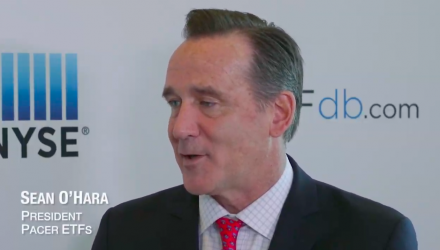Investors who are worried about sudden volatile swings can consider ETF strategies with a built-in hedging mechanism that shifts portfolio holdings to adapt to changing market conditions.
“We’re 10 years into a bull market here, so I think people are sort of waiting for the big one if you will. The last part of last year wasn’t even the big one, wasn’t even a bear market to be honest with you. There is a desire, especially with people near or in retirement, to have some part of the portfolio that will help them manage that downside risk and having a tactical choice certainly could help,” Sean O’Hara, President, Pacer ETFs, said at Inside ETFs.
Pacer Financial Inc. offers a suite of so-called Pacer Trendpilot ETFs, including the Pacer Trendpilot US Large Cap ETF (BATS: PTLC), Pacer Trendpilot US Mid Cap ETF (BATS: PTMC) and Pacer Trendpilot 100 ETF (BATS: PTNQ).
A Trend following strategy could diminish draw downs during bearish market conditions to help improve the overall, long-term investment returns. The Pacer Trendpilot strategy basically tries to participate in the market when it is trending up, pare back market exposure during the short-term market down trends, and prevent extended declines by moving to T-bills during long-term market down trends.
Specifically, the strategy follows strict guideline with three indicators, including an equity indicator, 50/50 indicator and a T-bill indicator.
The Equity Indicator refers to when the Benchmark Total Return Index closes above its 200-day SMA for five consecutive business days, the exposure will be 100% to the Benchmark Index. From the equity position, the Index will change to the 50/50 position or the T-Bill position depending on the 50/50 Indicator and the T-Bill Indicator.
The Price Signal 50/50 Indicator refers to when the Benchmark Total Return Index closes below its 200-day SMA for five consecutive business days, the exposure will be 50% to the Benchmark Index and 50% to 3-Month US Treasury bills. From the 50/50 position, the Trendpilot Index will return to the equity position or change to the T-Bill position depending on the Equity Indicator or T-Bill Indicator.
Lastly, the Trend Signal T-Bill Indicator refers to when the Benchmark Total Return Index’s 200-day SMA closes lower than its value from five business days earlier, the exposure will be 100% to 3-Month US Treasury bills. From the T-Bill position, the Trendpilot Index will change to the equity position when the Equity Indicator is triggered. It will not return to its 50/50 position unless the Equity Indicator is first triggered.
Watch the full video interview between ETF Trends CEO Tom Lydon and Sean O’Hara
For more ETF-related commentary from Tom Lydon and other industry experts, visit our video category.
